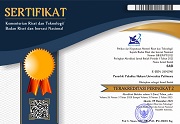Analysis of Neglected Justice in Land Disputes in Ambon District Court
 )
)
(1) Faculty of Law Pattimura University, Ambon, Indonesia
 Corresponding Author
Corresponding Author
Abstract
Introduction: The main task of a court judge is to receive, examine and adjudicate and settle every case that is brought to him. Judges may not refuse to examine and adjudicate cases submitted on the pretext that the law does not exist or is unclear, but is obligated to examine and try them. The study of this decision is to test whether the decision of the panel of judges in the court of first instance reflects a substantively fair decision.
Purposes of the Research: The purpose of this study is to criticize the legal considerations of judges on land disputes objectively.
Methods of the Research: The research method used is normative juridical research with a qualitative analytical descriptive nature, by examining legal materials, both primary legal materials and secondary legal materials through literature studies and other related literature.
Results of the Research: The analysis used in this study is a qualitative analysis to answer the problems studied. The results of the research and discussion stated that the judge's decision in the District Court Decision Number 242/Pdt.G/2020/PN.Amb was wrong and neglected to provide legal considerations as legal objectives, namely aspects of justice, aspects of expediency and aspects of legal certainty. In these aspects, the judge was wrong and wrong in considering the ownership of a plot of land with an area of 267 M2 with a Certificate of Ownership in the name of the Defendant, namely Hana Marthina Leuhery Number 1739/desa rumah three, 15-05-2011, Letter of Measurement dated 5 May 2011 according to PRONA from the national land agency, so that aspects of justice, aspects of usefulness and aspects of legal certainty are neglected.
Keywords
DOI
10.47268/sasi.v28i1.727
Published
2022-03-31
How To Cite
@article{SASI727,
author = {Ronald Saija},
title = {Analysis of Neglected Justice in Land Disputes in Ambon District Court},
journal = {SASI},
volume = {28},
number = {1},
year = {2022},
keywords = {Justice; Judge's Decision; Fair Decision},
abstract = {Introduction: The main task of a court judge is to receive, examine and adjudicate and settle every case that is brought to him. Judges may not refuse to examine and adjudicate cases submitted on the pretext that the law does not exist or is unclear, but is obligated to examine and try them. The study of this decision is to test whether the decision of the panel of judges in the court of first instance reflects a substantively fair decision.Purposes of the Research: The purpose of this study is to criticize the legal considerations of judges on land disputes objectively.Methods of the Research: The research method used is normative juridical research with a qualitative analytical descriptive nature, by examining legal materials, both primary legal materials and secondary legal materials through literature studies and other related literature.Results of the Research: The analysis used in this study is a qualitative analysis to answer the problems studied. The results of the research and discussion stated that the judge's decision in the District Court Decision Number 242/Pdt.G/2020/PN.Amb was wrong and neglected to provide legal considerations as legal objectives, namely aspects of justice, aspects of expediency and aspects of legal certainty. In these aspects, the judge was wrong and wrong in considering the ownership of a plot of land with an area of 267 M2 with a Certificate of Ownership in the name of the Defendant, namely Hana Marthina Leuhery Number 1739/desa rumah three, 15-05-2011, Letter of Measurement dated 5 May 2011 according to PRONA from the national land agency, so that aspects of justice, aspects of usefulness and aspects of legal certainty are neglected.},
issn = {2614-2961}, pages = {34--42} doi = {10.47268/sasi.v28i1.727},
url = {https://fhukum.unpatti.ac.id/jurnal/sasi/article/view/727}
}
Journal Article
A, Koesrin Nawawie. "Analisis Pertimbangan Majelis Hakim Dalam Perkara Perdata Tentang Wanprestasi Perjanjian Pemberian Imbalan Jasa." Jurnal Varia Hukum 31, no. 40 (2019): 1757-67.
Komisi Yudisial. "Mendorong Terwujudnya Kekuasaan Kehakiman Yang Merdeka." Buletin Komisi Yudisial 1, no. 5 (2007).
Nadapdap, Binoto. "Mendambakan Putusan Hakim Yang Berwibawa." Jurnal Keadilan 3, no. 2 (2003): 12-19.
Syamsudin, M. "Rekonstruksi Perilaku Etik Hakim Dalam Menangani Perkara Berbasis Hukum Progresif." Jurnal Hukum Ius Quia Iustum 8, no. Edisi Khusus (2011): 127-45.
https://doi.org/10.20884/1.jdh.2011.11.1.11
Wantu, Fence M. "Kendala Hakim Dalam Menciptakan Kepastian Hukum, Keadilan, Dan Kemanfaatan Di Peradilan Perdata." Mimbar Hukum 25, no. 2 (2013): 205-18.
https://doi.org/10.20884/1.jdh.2012.12.3.121
Book
Algra, N E, and K Van Duyvendijk. Mula Hukum: Beberapa Bab Mengenai Hukum Dan Ilmu Hukum Untuk Pendidikan Hukum Dalam Pngantar Ilmu Hukum. Translated by J C T Simorangkir. Jakarta: Bina Cipta, 1983.
Dimyati, Khudzaifah. Teorisasi Hukum Studi Tentang Perkembangan Pemikiran Hukum Di Indonesia 1945-1990. Surakarta: Muhammadiyah University Press, 2004.
Mertokusumo, Sudikno. Hukum Acara Perdata Indonesia. Yogyakarta: Liberty, 1998.
---. Mengenal Hukum: Suatu Pengantar. Yogyakarta: Liberty, 2010.
Rahardjo, Satjipto. Ilmu Hukum. Bandung: Citra Aditya Bakti, 2000.
Rahardjo, Satjipto, and Riduan Syahrani. Rangkuman Intisari Ilmu Hukum. Bandung: Citra Aditya Bakti, 1999.
Rifai, Ahmad. Penemuan Hukum Oleh Hakim Dalam Perspektif Hukum Progresif. Jakarta: Sinar Grafika, 2011.
Wignyosoebroto, Soetandyo. Hukum Paradigma, Metode Dan Dinamika Masalahnya, Elsam Dan Huma. Jakarta: Elsam dan Huma, 2002.
Thesis, Web Page, and Others
Komisi Hukum Nasional Republik Indonesia. "Laporan Akhir: Standar Disiplin Profesi Tahun 2003." Jakarta, 2004.
Wantu, Fence M. "Peranan Hakim Dalam Mewujudkan Kepastian Hukum, Keadilan, Dan Kemanfaatan, Di Peradilan Perdata." Universitas Gadjah Mada, 2011.
https://doi.org/10.20884/1.jdh.2012.12.3.121
| Dublin Core | PKP Metadata Items | Metadata for this Document | |
| 1. | Title | Title of document | Analysis of Neglected Justice in Land Disputes in Ambon District Court |
| 2. | Creator | Author's name, affiliation, country | Ronald Saija; Faculty of Law Pattimura University, Ambon; Indonesia |
| 3. | Subject | Discipline(s) | |
| 3. | Subject | Keyword(s) | Justice; Judge's Decision; Fair Decision |
| 4. | Description | Abstract | Introduction: The main task of a court judge is to receive, examine and adjudicate and settle every case that is brought to him. Judges may not refuse to examine and adjudicate cases submitted on the pretext that the law does not exist or is unclear, but is obligated to examine and try them. The study of this decision is to test whether the decision of the panel of judges in the court of first instance reflects a substantively fair decision.Purposes of the Research: The purpose of this study is to criticize the legal considerations of judges on land disputes objectively.Methods of the Research: The research method used is normative juridical research with a qualitative analytical descriptive nature, by examining legal materials, both primary legal materials and secondary legal materials through literature studies and other related literature.Results of the Research: The analysis used in this study is a qualitative analysis to answer the problems studied. The results of the research and discussion stated that the judge's decision in the District Court Decision Number 242/Pdt.G/2020/PN.Amb was wrong and neglected to provide legal considerations as legal objectives, namely aspects of justice, aspects of expediency and aspects of legal certainty. In these aspects, the judge was wrong and wrong in considering the ownership of a plot of land with an area of 267 M2 with a Certificate of Ownership in the name of the Defendant, namely Hana Marthina Leuhery Number 1739/desa rumah three, 15-05-2011, Letter of Measurement dated 5 May 2011 according to PRONA from the national land agency, so that aspects of justice, aspects of usefulness and aspects of legal certainty are neglected. |
| 5. | Publisher | Organizing agency, location | Faculty of Law, Universitas Pattimura |
| 6. | Contributor | Sponsor(s) | Ronald Saija, Pattimura University, Faculty of Law |
| 7. | Date | (YYYY-MM-DD) | 2022-03-31 |
| 8. | Type | Status & genre | Peer-reviewed Article |
| 8. | Type | Type | |
| 9. | Format | File format | |
| 10. | Identifier | Uniform Resource Identifier | https://fhukum.unpatti.ac.id/jurnal/sasi/article/view/727 |
| 10. | Identifier | Digital Object Identifier | 10.47268/sasi.v28i1.727 |
| 11. | Source | Title; vol., no. (year) | SASI; Volume 28 Issue 1, March 2022 |
| 12. | Language | English=en | en |
| 13. | Relation | Supp. Files |
Untitled (40KB) Untitled (40KB) |
| 14. | Coverage | Geo-spatial location, chronological period, research sample (gender, age, etc.) | |
| 15. | Rights | Copyright and permissions | Copyright: Authors who publish their manuscripts in this Journal agree to the following conditions: 1. The copyright in each article belongs to the author, as well as the right to patent. 2. Authors can enter into separate, additional contractual arrangements for the non-exclusive distribution of the journal's published version of the work (e.g., post it to an institutional repository or publish it in a book), with an acknowledgment of its initial publication in this journal. 3. Authors are permitted and encouraged to post their work online (e.g., in institutional repositories or on their website) before and during the submission process, as it can lead to productive exchanges, as well as earlier and greater citation of published work. 4. Authors have the right to self-archiving of the article (Author Self-Archiving Policy)
License: The SASI Journal is disseminated based on the Creative Commons Attribution-NonCommercial 4.0 International license terms. This license allows anyone to copy and redistribute this material in any form or format, compose, modify, and make derivatives of this material for any purpose. You cannot use this material for commercial purposes. You must specify an appropriate name, include a link to the license, and certify that any changes have been made. You can do this in a way that is appropriate but does not imply that the licensor supports you or your use.
|
Copyright (c) 2022 Ronald Saija

This work is licensed under a Creative Commons Attribution-NonCommercial 4.0 International License.

 : 2424 times
: 2424 times Download : 1060 times
Download : 1060 times
















